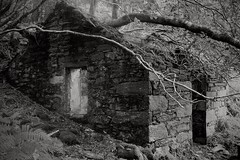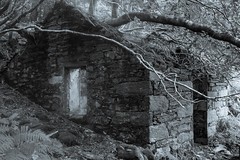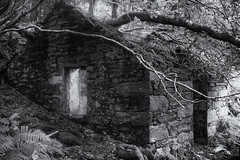This week I will mostly be playing with Adobe LightRoom 4 and Nik Silver Efex Pro in a Windows 7 VM under VirtualBox on Fedora 16. All in the name of fixing a few problems with my existing workflow, taking it up a notch and determining a secure future path. Yes, it involves running Windows - this is serious.
Up to now, I’ve done all my image postprocessing under Linux, using whatever the available tools were and without the benefit of monitor calibration, ICC profiles or much of the standard support offered to photographers using Windows or Mac. In summary, I’ve used:
- GIMP: Fine when starting out, but generally considered something of a joke for postpro due to its legacy 8 bit architecture. The GIMP is moving agonisingly slowly towards adopting a more modern image pipeline with GEGL, but it has taken ten years just to reach the point of “nearly there, any day now”. Almost no serious photographers would have remained with it over this period, although I did once see some outstanding photo art on Flickr produced with only a Canon A95 and the GIMP, which shows that anything is possible even with primitive tools if you have the talent. (I actually still print via GIMP because Gutenprint provides all the relevant options and gives very good results.) To be fair, most of the capabilities you’d want are there, it’s the obtainable image quality that is fatally compromised.
- Cinepaint: Short-lived 16 bit fork of the GIMP mainly intended for the film industry. Too unstable to rely on, and none of the available GIMP plugins were compatible.
- LightZone: Slightly laggy (it was written in Java) editor but with a unique and powerful zone paradigm in the interface. A great tool for producing output to fine art standards, but extremely time-consuming for large batches. The vendor, Light Crafts, disaporated a few years ago when the lead developer joined Apple and the product has been cast into limbo, which is a great shame. Some legacy support available via the LightZombie Project, but support for cameras from the last two years (i.e. most of the ones you are likely to be using) is lacking. I still break out LZ when I really want to go to town on a specific image.
- Bibble: The interface drove me nuts in version 4, but it was a commercially developed and supported tool available on Linux and there were some very nice B&W plugins for it (chiefly from Sean Puckett). Bibble V5 had almost morphed into a capable, professional image editor when it was acquired by Corel and renamed…
- AfterShot Pro: This is currently my main postpro tool, together with the Nostalgia and Toni plugins for B&W. I’ve even started using it for selective adjustments now that LZ is moribund. However, news broke over summer that Corel have let the original development team go, which doesn’t auger much confidence in its future, let alone that of the Linux version.
There’s more to this than simply finding an AfterShot replacement before the rug is pulled out from underneath. After several months of active browsing on Flickr, I’ve noticed an overall step change in the level of postprocessing skills on display (thinking particularly of a number of leading examples in the landscape field). About five years ago, the trend in landscape photography was towards super-saturated, radioactive wide angle views that largely mimicked and then surpassed the look of Velvia from the film age, as a result of which I lost interest in the genre (if anything, I inclined towards the opposite approach, hence Unpopped). But now the prevailing trend is towards a look that, while arguably still some way from the actualité, combines under-saturation with subtle colour-grading to enhance the drama of the scene. And yet detail is still preserved; rarely is any part either blown out or blocked up but the overall image contrast remains high and the clarity is breathtaking, as if the proponents have mastered and applied HDR techniques without importing that nightmarish HDR feel. The colours are somehow truer to life and yet hyper-real.
How is it done? I have no idea. With the earlier Velviariffic fad, it was easy to figure out - just whack all the sliders up to 11. This new vogue is far more artfully applied. It could be better cameras and lenses (everyone shoots a 5D Mark II now, right?), but the EXIF data suggests that the long-held truism remains - it’s not the camera. It would be doing some talented people a great disservice to suggest that their results are mainly a result of anything besides than their own care, abilities and experience. I’m sure they have invested a great deal of time and effort mastering their craft (and furthermore that their in-camera shots aren’t too shabby either).
Nonetheless, ‘the look’ in itself seems to have become too prevalent across the various fora and blogs to be ascribed purely to individual skill. I started to wonder whether there was a unifying factor - some commonly utilised set of commercial presets perhaps - behind this sea change in online imagery. My conclusion was that most of these photographers would not be struggling along with whatever they could cobble together on a Linux PC. They’d be using an Adobe workflow.
Coming from the open source world, we know that Adobe is Evil. They created and promoted Flash, for which alone they have a special room reservation in Hell. They regularly gouge their core Photoshop base on upgrade pricing and licensing costs. They hold several key imaging patents that retard the development of free alternatives such as the GIMP. And they still won’t port their best stuff to Linux.
But Adobe have been turning out image processing software for decades. They’ve poured a huge amount of time and resources into it (and they have not, to be fair, been slow to promote knowledge of how best to utilise their products). It’s not unreasonable to assume that at this point, their portfolio embodies the state of the art in image processing. My concern now is that anyone pushing their raw files through non-Adobe tools is already starting at a disadvantage to the Adobe users, and it will be much harder - if not impossible - to recover that lost ground in subsequent processing.
The only way to be sure was to give their software a try. I chose LightRoom 4, which can be downloaded free for a 30 day trial, and created a new Windows 7 64 bit VM in VirtualBox 4.2 for this purpose, giving it 2 CPUs, 1.6GB of RAM and a 25GB hard disk. I was initially curious to see whether it would even run acceptably well in that configuration, as I suspected it would demonstrate all the fluidity of molasses.
It doesn’t. I haven’t compared it to a native install, but it’s certainly responsive enough to be usable. Bear in mind that I haven’t gone to any great lengths to benchmark VirtualBox or tweak the configuration (there are suggestions that using only one CPU and disabling IO-APIC provides a 10% boost), and further that the virtual disks themselves are hosted on an NFS share so I/O rates are fairly poor. Given all that, the performance is impressive simply because it’s only adequate.
On the downside, the interface looks cramped and difficult to read. My VM is running in a 1024x768 window, which probably doesn’t help (main host resolution is 1184x864 so there isn’t much room to expand). LR adopts the same “light grey on dark grey” aesthetic as ASP, presumably to avoid overwhelming the subject picture, but it doesn’t make for clear visuals. Presumably there is some way to collapse the various panels and bars that surround the preview image to make it larger than what appears to be a glorified thumbnail, but I haven’t had chance to look yet.
What the methods and implications are of profiling and calibrating a virtual display, I have no idea.
To align with my own interests and bring things even closer to a “typical” modern postprocessing workflow, I also installed the 15 day trial version of Nik Software’s Silver Efex Pro 2 plugin for monochrome conversion. Interestingly, the “plugin” capability basically functions as an external editor (rather than in the Firefox sense of a tightly-coupled library module) with a small amount of menu integration in LR; the selected image is exported as a TIFF file which is edited in SEP and then saved back to the same file for re-import to LR. I wondered why Nik didn’t offer SEP and its other tools in standalone versions, perhaps integrating dcraw to perform the initial RAW conversion. Given that SEP can perform most or all of the manipulations you’d do in LightRoom anyway, but in a way more suitable for purpose, LR appeared to be the Adobe Tax you had to pay to start SEP. It turns out that you can run SEP as an isolated application against TIFF files, so LR is really just a wrapper for the overall workflow and asset management.
Enough wibbling, some examples. My recent dissatisfaction with AfterShot stems from a batch of vacation images I processed. Too many of the mono conversions seemed to come out as a kind of low contrast, grey mush, hazy and lacking detail. Here’s an example. The detail’s all there, but the overall impact is muted and rather hazed.
Here’s the same image converted and processed purely in LR4. As you can see, it isn’t greatly different except that I’ve used LR’s selenium toning preset for this (just because). Note that the crop and apparent angle varies slightly though; LR doesn’t seem to recognise Panasonic cameras and lenses so I think it hasn’t performed any lens correction (which ASP does); maybe I also need Adobe Camera Raw for this? [Update: ACR is built into LightRoom and m4/3 lens corrections are applied automatically on import based on the metadata in the raw file.]
Here’s the image again processed entirely in SEP2. This has much more contrast, clarity and detail (compare the fern in the bottom left corner for example). The highlight area on the right hand edge is too distracting and needs toning down, but the gable opening has the presence it demands. Overall, I prefer this rendition and the fact that I got to this point fairly directly is a bonus. The key advantage of SEP here is that its presets are excellent (HP5 FTW!), and the remaining controls only need a fine tweak to finish things off.
It’s early days yet; the above is the result of only one brief session. I haven’t attempted any serious colour work in LR yet, which would be the acid test (hmm, maybe using Nik Color Efex?). But I have drawn some early conclusions:
- There may be some secret sauce in LR that puts it ahead of other editors, but it isn’t readily apparent at first blush. I suspect familiarity with the software trumps capability of the software when it comes to the final result, regardless of what you use. Certainly twenty minutes of fiddling in LR didn’t produce anything markedly better than I had already achieved with ASP, which was my greatest apprehension before starting.
- I suspect my dissatisfaction with my low contrast results stems partly from the fact that the original images were shot on a low contrast kind of day, and partly from timidity on my own part when processing the image. I seem to have retained a dogmatic hang-up about preserving a full tonal scale, without considering whether something more dramatic would suit the picture better even if some of the finest detail goes AWOL. (My tastes incline towards higher contrast lately, but my own output doesn’t appear to have caught up.)
- For monochrome work, I don’t see why you’d need LightRoom as well as SEP, except for convenience. There are other, cheaper solutions for raw conversion and asset management.
- If Corel do their worst, I could put my hand in my pocket and fork out for LR & SEP to allow me to continue my digital photography in reasonable comfort, albeit in a virtualised Windows world. Factor in some time to port my custom ASP presets over though.
[Update: Have a look at these filter examples for Nik’s Color Efex Pro. Do we think this may explain the ‘hyper-real’ colour grading and saturation of current digital images? Yes we do. So maybe it is partly down to a set of magic presets after all.]
Other bubbles
- Tim Bray has also been rethinking his desktop toolset:
“As for Lightroom, I’m starting to wonder if running it in a Windows VM … is an entirely insane idea.”



